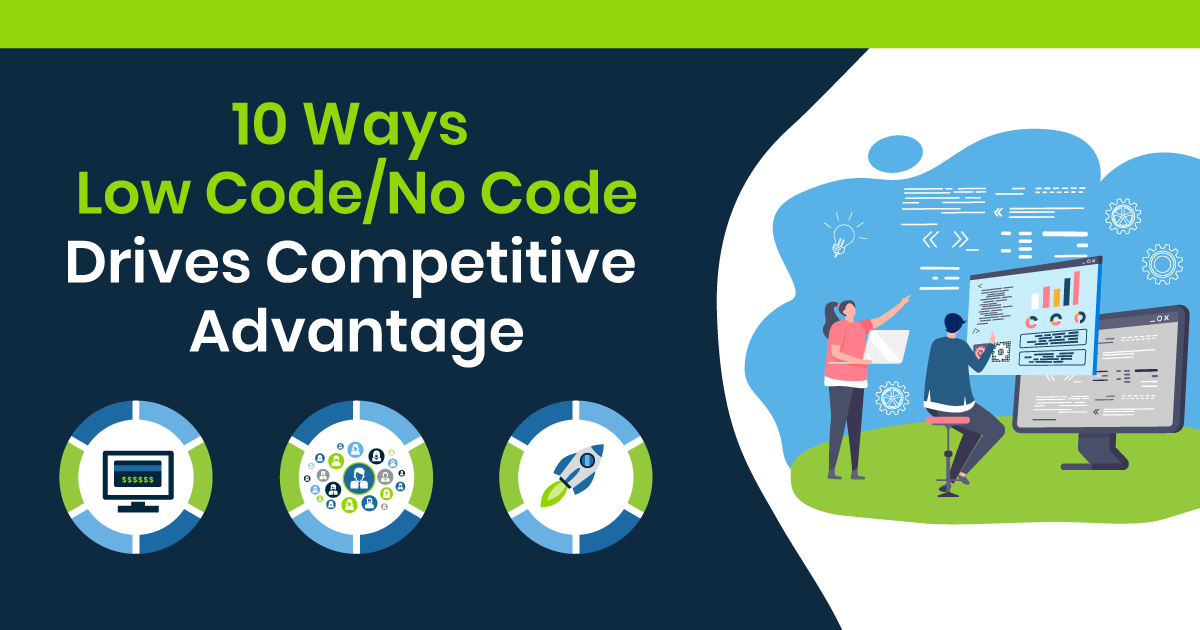
10 Ways Low Code/No Code Drives Insurer Competitive Advantage
It takes agility and innovation to gain any competitive edge in today’s digital insurance marketplace. The increasing customer demand for a superior digital experience has driven the need for insurers to accelerate their digital strategies and innovate with next-generation technologies. But although digitization has been a critical focus for the insurance industry, a recent J.D. Power survey revealed that very few insurers currently deliver a highly personalized and improved digital experience.1
Product Development That’s Never Quite Fast Enough
One of the biggest obstacles insurers face with digital transformation is bridging the widening gap between customer expectations and the speed at which development teams can actually deliver that frictionless experience. Insurance product development normally spans many months before getting to the point of implementation and ‘go live’, only to end up still behind the curve after investing significant resources, just never quite making it to market fast enough. But the low code/no code revolution is changing that dynamic and empowering insurers with the ability to develop much faster at lower costs, driving both growth and value.
What is Low Code/No Code?
No-code and low-code platforms provide insurers with visual tools to develop software easily and quickly. Low code is a visual approach to software development that minimizes the amount of coding required to deliver custom software. No code platforms provide templates with drag and drop visual editing tools that allow users to build applications and websites from existing elements without actually writing code.
Adoption of Low Code/No Code Platforms
Widespread adoption of low code/no code platforms is increasing rapidly. According to Forrester, adoption of low code platforms could easily reach 75% in 2021, partly due to the remote working conditions and product demands brough on by the pandemic2. Similarly, Novarica research found that adoption of low code/no code development platforms were on the rise as insurers accelerated their digital transformation efforts.3
Let’s look at 10 ways in which low code/no code drives insurer competitive advantage:
1. Low Code/No Code Increases Speed to Market
Low Code/No Code platform vendors claim a significant increase in speed to market than that of traditional software development – 10 x faster – due to many factors: the efficiency of visual modeling tools, the greater availability of resources, the lack of lengthy project approval and funding protocols, the enablement of agile methods, and the value of active business area involvement.
2. Low Code/No Code Lowers Costs
Less time and effort spent in coding easily translates into less technical overhead and a reduced level of investment for insurers already under extreme pressure to effectively manage expenses while aggressively pursuing digital transformation and an improved customer experience.
3. Low Code/No Code Enables Testing
Low code/no code development greatly enables agile methodology and faster prototyping and delivery with simple drag and drop tools. Teams can quickly build, test, and iterate.
4. Low Code/No Code Minimizes Risk
When development teams have the ability to create with ease, ‘fail fast’, and improve quickly, they can then win even faster. When projects takes less time, effort and resources, risk is greatly reduced.
5. Low Code/No Code Increases Innovation
Low code/no code development enables collaboration that fosters design thinking and experimentation, accelerating the innovation and growth necessary for insurers to gain a competitive edge.
6. Low Code/No Code Improves Customer Experience
A Celent study revealed that almost 90% of insurers rated customer experience as extremely important for generating new business, and almost 80% stated that responding to customer needs made digital transformation a priority. Low code/no code platforms provide insurers the ability to build and deliver the omnichannel digital experience customers demand.4
7. Low Code/No Code Increases Customer Retention
Low code/no code development gives insurers the tools to respond quickly to market demands and the capabilities to meet customer expectations for flexibility, speed, and ease of use. Building and testing in real time allows insurers to rapidly reduce the friction in the customer journey that causes churn.
8. Low Code/No Code Drives Automation
Low code/no code tools provide insurers with the capability to quickly and easily create simple digital workflows that drive automation and increase customer connectivity.
9. Low Code/No Code Facilitates Business & IT Collaboration
Low Code/No Code development facilitates improved collaboration among business and IT units, enables agile methodologies and empowers cross functional teams, leading to stronger relationships that breed both quality and innovation.
10. Low Code/No Code Expands Development Resources
Rapid digital transformation has only exacerbated an already existing gap in software engineers. Finding skilled developers who also understand the nuances of insurance is especially challenging. Since low code/no code development requires little technical knowledge, business partners are empowered to design, build and test, expanding development resources that contribute to growth.
Low Code/No Code Enables Agility, Flexibility, and Innovation
The demand for real-time responsiveness is at an all-time high and shows no signs of slowing down any time soon. Low code/no code tools enable the agility, flexibility, and innovation needed to meet that demand. Novarica has projected that by 2025, at least 80% of custom development projects in the industry will involve low-/no-code technology.5 Insurers who take advantage of low code/no code tools to build, test, and deploy products rapidly, will undoubtedly gain a competitive advantage in today’s digital insurance marketplace.
One Inc
We’re here to help. Our reimagined inbounds payment platform, PremiumPay® 2.0, features a low code/no code user interface that provides insurers unparalleled speed, usability and customization. Our comprehensive digital payment solution enables insurers to transform the insurance payment experience. And our omnichannel digital communication capabilities allow insurers to proactively engage policyholders on the channels they prefer. At One Inc we provide carriers with the ability to give their customers what they want and expect: control, convenience, consistency, and continuity.
To discuss your digital payment needs, please call (822) 209-1688 or email inquiries@OneInc.com.
Sources:2Oct 2020, https://www.techrepublic.com/article/why-2021-will-be-the-year-of-low-code/
Written by The One Inc Content Team
Want to read more articles like this?

